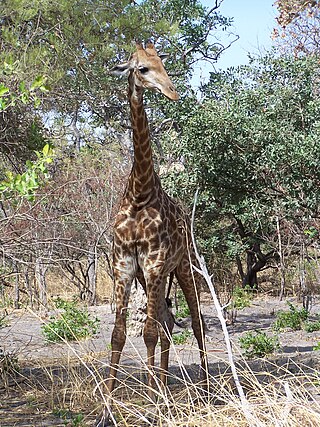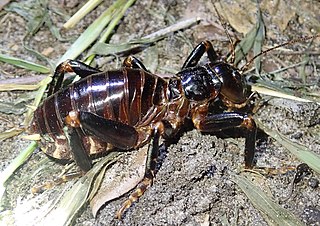
The Araliaceae are a family of flowering plants composed of about 43 genera and around 1500 species consisting of primarily woody plants and some herbaceous plants. The morphology of Araliaceae varies widely, but it is predominantly distinguishable based on its woody habit, tropical distribution, and the presence of simple umbels.

Joseph Gedaliah Klausner , was a Lithuanian-born Israeli historian and professor of Hebrew literature. He was the chief redactor of the Encyclopedia Hebraica. He was a candidate for president in the first Israeli presidential election in 1949, losing to Chaim Weizmann. Klausner was the great uncle of Israeli author Amos Oz.

The family Gryllidae contains the subfamilies and genera which entomologists now term true crickets. Having long, whip-like antennae, they belong to the Orthopteran suborder Ensifera, which has been greatly reduced in the last 100 years : taxa such as the spider-crickets and allies, sword-tail crickets, wood or ground crickets and scaly crickets have been elevated to family level. The type genus is Gryllus and the first use of the family name "Gryllidae" was by Francis Walker.
Stenopelmatus is one of two genera of large, flightless insects referred to commonly as Jerusalem crickets. They are primarily native to Central America, and one species is known from Ecuador.

Thomas Lockyer was a famous English cricketer during the game's roundarm era. He was one of the outstanding wicket-keepers of the 19th century.

Translocation in wildlife conservation is the capture, transport and release or introduction of species, habitats or other ecological material from one location to another. It contrasts with reintroduction, a term which is generally used to denote the introduction into the wild of species from captive stock. The International Union for the Conservation of Nature (IUCN) catalogues translocation projects for threatened species around the globe.

Ammopelmatus is a genus of insects in the family Stenopelmatidae, one of two genera of large, flightless insects referred to commonly as Jerusalem crickets. They are native to western United States and northwestern Mexico.

Ammopelmatus muwu is a species of insect in family Stenopelmatidae. It is endemic to parts of San Luis Obisbo and Santa Barbara counties in United States state of California.
Ammopelmatus navajo, commonly known as the Navajo Jerusalem cricket, is a species of nocturnal Jerusalem cricket in the family Stenopelmatidae. It is endemic to the United States, specifically Arizona, and found under rocks in loose soil. It is closely related to A. fuscus and they have nearly identical drumming patterns. They live one to two years as adults, but can die prematurely by parasitic infections, commonly by the horsehair worm.
Ammopelmatus nigrocapitatus is a species of insect in the family Stenopelmatidae. It is endemic to parts of Southern California.

Gryllacrididae are a family of non-jumping insects in the suborder Ensifera occurring worldwide, known commonly as leaf-rolling crickets or raspy crickets. The family historically has been broadly defined to include what are presently several other families, such as Stenopelmatidae and Rhaphidophoridae, now considered separate. As presently defined, the family contains two subfamilies: Gryllacridinae and Hyperbaeninae. They are commonly wingless and nocturnal. In the daytime, most species rest in shelters made from folded leaves sewn with silk. Some species use silk to burrow in sand, earth or wood. Raspy crickets evolved the ability to produce silk independently from other insects, but their silk has many convergent features to silkworm silk, being made of long, repetitive proteins with an extended beta-sheet structure.

Jerusalem crickets are a group of large, flightless insects in the genera Ammopelmatus and Stenopelmatus, together comprising the tribe Stenopelmatini. The former genus is native to the western United States and parts of Mexico, while the latter genus is from Central America.

Crickets are orthopteran insects which are related to bush crickets, and, more distantly, to grasshoppers. In older literature, such as Imms, "crickets" were placed at the family level, but contemporary authorities including Otte now place them in the superfamily Grylloidea. The word has been used in combination to describe more distantly related taxa in the suborder Ensifera, such as king crickets and mole crickets.

Stenopelmatoidea is a superfamily of insects in the order Orthoptera; in some older classifications this group was referred to as Gryllacridoidea.

Grylloidea is the superfamily of insects, in the order Orthoptera, known as crickets. It includes the "true crickets", scaly crickets, wood crickets and other families, some only known from fossils.

The cohort Polyneoptera is a proposed taxonomic ranking for the Orthoptera and all other Neopteran insects believed to be more closely related to Orthoptera than to any other insect orders. These winged insects, now in the Paraneoptera, were formerly grouped as the Hemimetabola or Exopterygota on the grounds that they have no metamorphosis, the wings gradually developing externally throughout the nymphal stages.
Ammopelmatus pictus is a species of Jerusalem cricket in the family Stenopelmatidae. It is found in parts of the Central Valley, Diablo Range, and Silicon Valley within California.

Stenopelmatinae is the sole subfamily in the family Stenopelmatidae. There are about 7 genera and more than 50 described species in Stenopelmatinae.
Ammopelmatus longispina is a species of Jerusalem cricket in the family Stenopelmatidae. It is found in North America.












